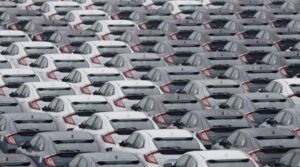- The US economy’s V-shaped recovery is “in tatters”, due to rising coronavirus cases and new restrictions, according to Yale economist and former Morgan Stanley Asia chair Stephen Roach.
- Roach said the dollar could drop around 20% this year, thanks to the growing US budget deficit and next-to-zero interest rates at the Federal Reserve.
- The former bank chair said the stock markets ‘do not seem to care’ about anything other than stimulus from the Fed.
The US economy’s recovery is in “tatters” after the latest rise in coronavirus cases and new restrictions, while the dollar could fall another 20% amid low interest rates and a yawning budget deficit, according to Yale economist and former bank chairman Stephen Roach. “The economy is slipping right before our very eyes,” Roach said in an interview, yet “the markets do not seem to care.” Roach pointed to recent economic data such as falling retail sales in November, a drop in consumer confidence and rising unemployment in December. The former chair of Morgan Stanley Asia said a “double-dip” recession is now likely. Explaining the recent rise in US stocks to all-time highs, Roach said investors were almost solely focused on Federal Reserve monetary policy.
“The markets are focusing really on one thing and that is the Federal Reserve holding interest rates at zero, no matter what happens,” he said.
“That gives the markets conviction to look through literally anything, from political insurrection to the likelihood of a double-dip, to a V-shaped recovery that’s in tatters. The markets do not seem to care.” Markets have also focused on the likelihood of more stimulus under President-elect Joe Biden and the Democrats, who last week won elections that will give them control of Congress. The Democrat victories in Georgia allowed markets to shrug off unprecedented scenes in Washington DC, where pro-Donald Trump protesters stormed the Capitol Building last week. Roach said more stimulus is “appropriate given the severe economic distress that continues to persist”. Yet he said there would be “consequences”. A higher budget deficit would lower domestic savings and increase the current account deficit, Roach argued, combining with ultra-loose monetary policy to hit the dollar. “I do see another 15 to 20% downside to the broad dollar index over the course of this year,” Roach said. The dollar has fallen more than 7% against a basket of currencies since January 2020. He said this reflected “not just the current account deficit, but the strength of the euro”. Roach added that, “most importantly”, the Fed holding interest rates at zero would forestall “a normal interest-rate hike that might otherwise boost the dollar”. However, the dollar has climbed more than 0.5% so far this year, taking the dollar index to 90.44. Rising bond yields and the prospects of higher growth have made the currency and US assets more attractive to non-US investors. Meanwhile, the division between the health of the US economy and markets continues to widen. Markets are riding the wave of monetary and fiscal stimulus and looking ahead to the middle of the year, when they hope vaccines will have allowed some semblance of normal life to return. Roach said stimulus may cause inflation “down the road”. But he said: “With aggregate demand remaining weak in the US, I think it’s going to take a while before that shows up.”

